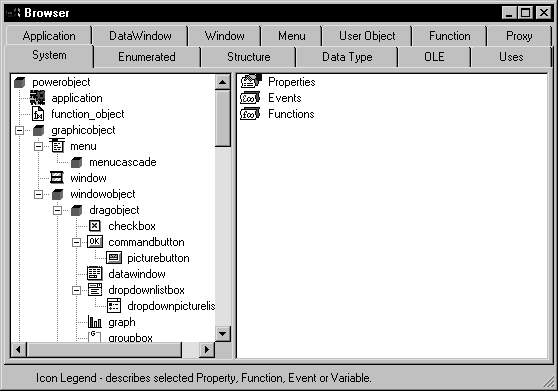PocketBuilder provides a Browser that can show the hierarchy of the built-in PocketBuilder system objects and the hierarchy of the ancestor and descendent windows, menus, and user objects you create. In object-oriented terms, these are called class hierarchies: each PocketBuilder object defines a class.
Figure 12-2: Displaying the hierarchy of system classes in the Browser

![]() Regenerating objects
The Browser also provides a convenient way to regenerate objects
and their descendants. For more information, see “Regenerating library entries”.
Regenerating objects
The Browser also provides a convenient way to regenerate objects
and their descendants. For more information, see “Regenerating library entries”.
![]() To browse the class hierarchy of PocketBuilder
system objects:
To browse the class hierarchy of PocketBuilder
system objects:
Click the Browser button in the PowerBar.
Choose the System tab to show the built-in PocketBuilder objects.
In the left pane, scroll down the object list and select “powerobject”.
Display the pop-up menu for powerobject and choose Show Hierarchy.
Select Expand All from the pop-up menu and scroll to the top.
The hierarchy for the built-in PocketBuilder objects displays.
![]() To display the class hierarchy for other object
types:
To display the class hierarchy for other object
types:
Choose the Menu, Window, or User Object tab.
If you choose any other object type, there is no inheritance for the object type, so you cannot display a class hierarchy.
In the left pane, select an object and choose Show Hierarchy from its pop-up menu.
Select an object and choose Expand All from its pop-up menu.
PocketBuilder shows the selected object in the current application. Descendent objects are shown indented under their ancestors.